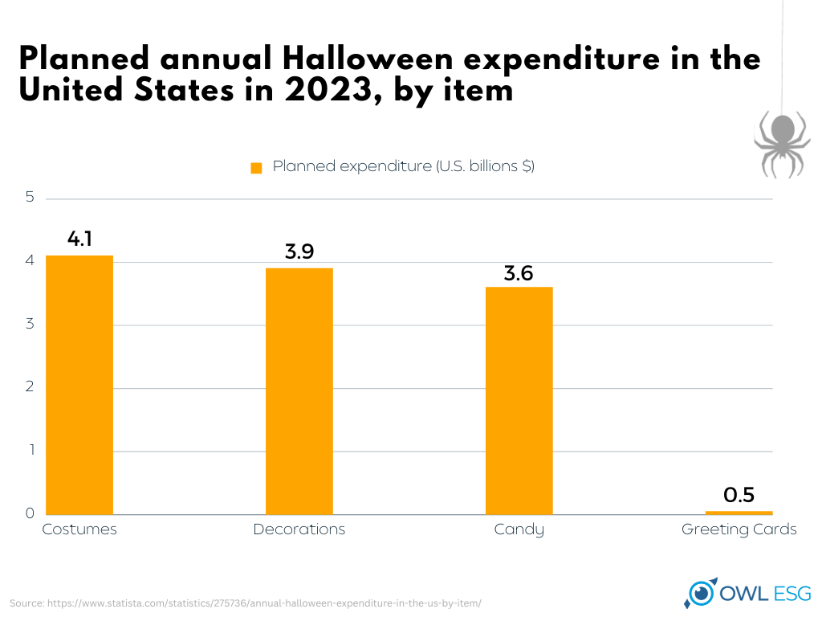From creative paper bag outfits to eerily lifelike zombies and houses adorned with creepy decals, Halloween showcases a wide array of creativity. Though, beyond the spooky embellishments, latest horror films, and eerie costumes, have you ever contemplated the environmental impact Halloween can have?
Carving eerie faces into pumpkins is a common October tradition, but it might have a more significant impact on the environment than we consider when we put out our Jack-O-Lantern. In fact, a majority of the 900,000 tons of pumpkins that are produced in the U.S. every year are thrown away. To put this number into perspective, in 2022 alone, roughly 16.4 million pumpkins were grown in the U.S.
When pumpkins are disposed of in landfills, they don’t decompose as they would naturally in the soil. Instead, they break down in a way that leads to the release of methane gas—a potent greenhouse gas that accelerates climate change. The United Nations Environment Program states that methane gas is the “primary contributor to the formation of ground-level ozone, a hazardous air pollutant and greenhouse gas, exposure to which causes 1 million premature deaths every year. Methane is also a powerful greenhouse gas. Over a 20-year period, it is 80 times more potent at warming than carbon dioxide.”
The question then remains: What should we do with our deteriorating leftover pumpkins adorning our front porches if we can’t dispose of them?
Pumpkin power
Rather than contributing to emissions, pumpkins and other holiday waste have the potential to be transformed into energy through anaerobic digestion, where microorganisms break down organic waste within a sealed tank that’s heated to expedite the breakdown. The biogas created can then be harnessed to produce electricity for powering households, fueling vehicles, and generating heat.
Composting at home
The best way to dispose of pumpkins is letting them naturally decompose into the soil. This can be best accomplished through composting, a process that combines various decaying organic materials to produce nutrient-enriched soil.
Composting facilities may be available in your local area; however, many communities allow for at-home composting as well. All you need are basic gardening tools and a composting bin. Depending on how fast you want your pumpkin to compost, there are two methods to choose from: fast compost (4 weeks-1 year) and slow compost (1 year-18 months). After the compost has fully matured, you can incorporate it into your yard’s soil, use it as fertilizer in a home garden, or utilize it as mulch.
Yard waste collecting
In certain communities with yard waste collection services, remaining pumpkins can be given to yard waste collectors. It never hurts to check whether your community offers curbside yard waste pickup or if you need to deliver it to a designated facility.
Leftovers for you and your furry friends
If you’re still keen on the joy of pumpkin carving and are an avid food lover like me, ensure it doesn’t go to waste by baking a delicious pumpkin pie, or roasting its seeds or segments in the oven for a savory treat (even the skin can be enjoyed).
Pumpkins are also safe for pets to consume, so go ahead and offer some to your furry friends! However, note that cats should only be given cooked or canned pumpkin, as raw pumpkin can be difficult for them to digest. While pumpkin is also an excellent source of fiber for animals, be cautious not to overfeed them.
Spooky environmental consequences
Perhaps the scariest aspect of Halloween lies not within the holiday itself, but in what happens to all the purchased items and decorations during and after the celebrations. One of the most significant and concerning issues related to Halloween revolves around the plastic waste and environmental pollution generated during this time.
Plastics can be found in wigs, cosmetics, toys, candy wrappers, and a variety of products and items used for decorating and celebrating the holiday. Plastics are cheap, easily manufacturable, and very durable due to their chemical makeup. They consist of polymers (long chains of molecules) which are challenging to break down. Because they’re resistant to decomposition, when introduced into the environment, it can take up to hundreds of years for polymers to break down.
Most plastics don’t make it to landfills, let alone recycling. Instead, plastic often ends up polluting the environment, carried away by the wind or consumed by animals, eventually finding their way into the sea.
But no need to fret because there are many ways to maintain Halloween’s spooky and delightful charm while being eco-conscious. Here are some tips to help you make environmentally responsible yet enjoyable decisions this ghostly season.
Costumes, cosmetics, and decorations
Halloween costumes and makeup often contain PVC plastics, notorious for being hard to recycle and posing risks to both human health and the environment. They exhibit high flammability and emit toxins, polluting not only water but also the air.
Cosmetics and theatrical makeup products can harbor hazardous chemicals that pose potential harm to our well-being and are found in products like fake blood and face paints. When purchasing cosmetics, look at the ingredients and steer clear of substances like coal, tar dyes, parabens, and other harmful toxins. It’s a great idea to look for cosmetic brands like Dab Herb Makeup with eco-friendly labels.
When it comes to the plastic waste generated from costume purchases, consider reusing old costumes in innovative ways or opting for used instead of new. This not only minimizes waste but also lightens the burden on your budget.
Using non-plastic alternatives is another great way to avoid plastic and decoration waste. Fabric costumes can be easily modified and repurposed, providing endless opportunities for new and spooky Halloween themes in the future.
Stores are brimming with Halloween decorations, but a significant portion of these items rely on electricity. Producing these products consumes substantial resources, including copious amounts of copper wiring and certain scarce materials like lanthanum, a vital element used in modern television sets, energy-efficient bulbs, and optical lenses. When discarded, they contribute to the growing electrical waste crisis.
This year, consider reusing plastic pumpkin decorations or opting for fabric or ceramic instead of plastic. These alternatives can last longer and can be used beyond the fall season.

Trick or treats
Treats are an essential part of Halloween. Plastic waste remains a concern when purchasing and eating yummy candies and other sweet delights. Although small, their collective impact is significant—imagine all the times you’ve come across candy or wrappers littered around bus stops, roads, streets, or playgrounds. Choosing candies with non-plastic packaging like cardboard or paper boxes can help mitigate this issue.
Candy corn
Is it a delightful treat or a playful trick from candy manufacturers? If you’re someone who lives off candy corn during Halloween, you may want to reconsider.
- 12 ingredients: This candy includes four sweeteners like sugar, corn syrup, dextrose, and honey, along with artificial food colorings like Yellow 6, Yellow 5, and Red 3, which have been scrutinized for possible negative effects.
- Potential carcinogenic colors: Although Yellow 6 carries FDA approval, a study on food dye hazards by the Center for Science in the Public Interest (CSPI) found its potential to induce tumors in animal experiments. Additionally, both Yellow 6 and Yellow 5 pose a risk of contamination by substances or chemicals that can become cancer-causing once entered the body—a critical detail not typically disclosed on packaging.
- Itching and hives: Though approved for use in the U.S., Yellow 5 coloring is linked to rare but sometimes severe allergic reactions, possibly due to manufacturing impurities.
- Outer coating & bugs: The ingredient label identifies candy corn’s glossy coating as confectioner’s glaze, but it’s also referred to as lac-resin, derived from lac bugs, vivid red insects native to Asia.
- Long shelf life: While sugar is a natural preservative that extends the shelf life of food, candy corn also includes 70 milligrams of salt, which acts as an additional preservative and is why an opened bag of candy corn can remain fresh for up to six months.
- Artificial flavoring: Candy corn’s taste comes from artificial flavoring, including any of the 700 FDA-approved additives as well as additional 2,000 other chemicals that aren’t directly regulated by the FDA.
When trick-or-treating, use bags that aren’t made of plastic, like pillowcases. Additionally, setting up a trash or recycling bin outside your home encourages responsible waste disposal and prevents trick-or-treaters from throwing away garbage wherever they please.
As Halloween approaches, it’s essential to reflect on the environmental consequences of our traditions and consider how we can make this spooky season more sustainable. Carving pumpkins is a time-honored practice, but when they end up in landfills, they contribute to the release of methane gas, a potent greenhouse gas with severe consequences for climate change.
By composting, reusing, and repurposing, we can transform our seasonal waste into valuable resources, powering homes, and reducing harmful emissions. Beyond pumpkins, Halloween generates a significant amount of plastic waste, from costumes to decorations. But by opting for eco-friendly choices and creative recycling, we can enjoy a more environmentally responsible and enjoyable Halloween.
The Armchair ESG with Nate and Yates
delve deeper into this subject.
Click on the link to listen/watch our podcast.




